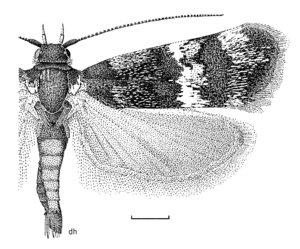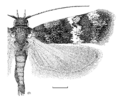Hierodoris polita facts for kids
Quick facts for kids Hierodoris polita |
|
|---|---|
 |
|
| Scientific classification | |
| Kingdom: | |
| Phylum: | |
| Class: | |
| Order: | |
| Family: |
Oecophoridae
|
| Genus: | |
| Species: |
H. polita
|
| Binomial name | |
| Hierodoris polita Hoare, 2005
|
|
Hierodoris polita is a special type of moth that belongs to the Oecophoridae family. This moth is found only in New Zealand, which means it is endemic to that country. The New Zealand Department of Conservation has listed H. polita as "At Risk, Naturally Uncommon." This means it's a rare species that needs our attention to stay safe.
Contents
About Hierodoris polita
How it got its name
This moth was first officially described in 2005 by a scientist named Robert J. B. Hoare. He gave it the scientific name Hierodoris polita. Before it had this official name, people sometimes called it H. ‘silver banded’ because of its appearance.
The main specimen used to describe the species, called a holotype, was collected by John S. Dugdale. It was found in the Clutha Valley in New Zealand on March 16, 1986. This important specimen is now kept at the New Zealand Arthropod Collection.
What does H. polita look like?
The size of H. polita moths can vary a bit. Male moths usually have a wingspan (the distance from one wingtip to the other) between 11 and 14.5 millimeters. Females are slightly larger, with a wingspan of 12.5 to 13.5 millimeters.
H. polita looks very similar to two of its close relatives: Hierodoris frigida and H. extensilis. However, there are a few key differences that help scientists tell them apart.
How to tell it apart from H. frigida
H. polita is different from H. frigida in a few ways:
- H. polita does not have an all-yellow second segment on its labial palp (a small sensing part near its mouth).
- It also lacks a yellowish-white spot on its costa (the front edge of its wing).
- The back part of the tegulae (small flaps covering the base of the wings) on H. polita has white scales, while H. frigida has dark tegulae.
- H. polita has a white band across its front wing that H. frigida does not have.
How to tell it apart from H. extensilis
You can tell H. polita from H. extensilis by these features:
- H. extensilis has a white base on its hindwing, but H. polita has a bronzy (bronze-colored) base.
- The outer surface of the labial palpi on H. extensilis is covered in white scales, while H. polita's are dark.
- H. polita has a white band across its front wing, which is missing in both H. extensilis and H. frigida.
Where does H. polita live?
This moth is found only in New Zealand. Specifically, you can find H. polita in the South Island, mainly in the Central Otago and Dunedin areas. Because it's only found in these specific places, it's considered "range restricted," meaning it has a very local distribution.
Life and habits of H. polita
What do they eat?
Scientists haven't officially identified the larvae (caterpillars) of H. polita yet. However, a likely larva was found in leaf litter, which is dead leaves and plant material, especially from a moss called Grimmia laevigata. This suggests that the larvae of H. polita might be detritivores. A detritivore is an animal that eats dead organic material, like decaying plants.
When are they active?
Adult H. polita moths have been seen flying during certain months. They are usually active in October, November, and then again from January to March.
Where do they live and what plants do they like?
H. polita moths prefer to live in open areas. So far, they have mostly been found on rocky bluffs that face south. These bluffs are often covered with different types of Grimmia moss. This suggests that the moss might be important for their habitat or even for their diet.
Conservation status
The H. polita moth is listed as "At Risk, Naturally Uncommon" under the New Zealand Threat Classification System. This means that while it's not critically endangered, it's naturally rare and needs to be monitored to ensure its population stays healthy and doesn't decline.
Images for kids


